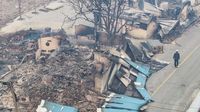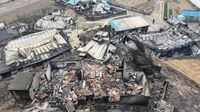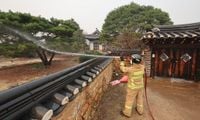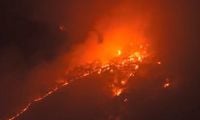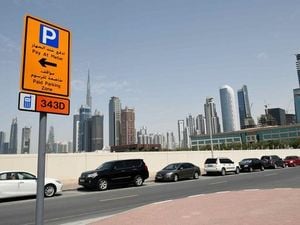Wind-driven wildfires in South Korea have wreaked havoc across the southern regions, leading to a staggering death toll of 24 individuals, the destruction of over 200 structures, and the evacuation of approximately 27,000 residents. The wildfires, which began on March 22, 2025, have been described as some of the worst in the country’s history, with Acting President Han Duck-soo declaring them the most severe yet.
The catastrophic events unfolded primarily in North Gyeongsang Province, particularly in towns like Uiseong, Andong, and Yeongdeok. Tragically, among the deceased was a helicopter pilot who lost his life when his aircraft crashed while battling the flames in Uiseong, a town severely affected by the fires. The National Fire Agency reported that at least 26 others sustained various injuries during this crisis.
As of March 26, the wildfires have consumed 175 square kilometers (about 43,330 acres) of land, prompting a massive mobilization of resources. Approximately 4,650 firefighters, soldiers, and emergency personnel were deployed, supported by around 130 helicopters. Despite their efforts, strong winds have complicated firefighting efforts, and officials are bracing for the possibility of unprecedented damage.
In a televised address, President Han stated, "Damages are snowballing. There are concerns that we’ll have wildfire damages that we’ve never experienced, so we have to concentrate all our capabilities to put out the wildfires in the rest of this week." He also mentioned that a small amount of rain was expected, which could provide some relief.
The fires have had devastating impacts on cultural heritage sites as well. The Gounsa Buddhist temple, which dates back to the seventh century, suffered significant damage, with nearly half of its structures destroyed. Among the lost artifacts were two state-designated treasures—a pavilion built in 1668 and a structure from the Joseon Dynasty erected in 1904.
Evacuations were ordered in multiple areas, including the UNESCO-listed Hahoe Folk Village in Andong, where residents were alerted to seek shelter as the flames approached. The village, famous for its historical significance and traditional architecture, was under threat as smoke began to envelop the area. Authorities confirmed that the village's 200 residents were evacuated early on March 26.
In Yeongyang County, five victims were found dead, including four family members who had sought refuge in a designated safe area. Others lost their lives during chaotic evacuations, with some succumbing to smoke inhalation or traffic accidents. Reports indicate that elderly individuals, particularly those with mobility issues, were disproportionately affected, highlighting systemic failures in evacuation protocols.
Officials have raised the national wildfire alert to its highest level, prompting stricter regulations and emergency measures. The Korea Forest Service has mandated local governments to increase personnel for emergency response, tighten access to forests, and recommend military units refrain from live-fire exercises.
Amidst the chaos, authorities are investigating the causes of the wildfires, with initial reports suggesting human error may have played a role. Suspicions include improper use of fire during grass clearing or sparks from welding activities. These factors have raised questions about the adequacy of existing fire prevention measures.
On March 25, the Ministry of Justice confirmed the evacuation of approximately 2,600 inmates from four prisons in Cheongsong County due to the approaching wildfires. This precautionary measure underscores the severity of the situation as officials work to ensure public safety.
As the fires continue to rage, the government faces mounting pressure to address the high casualty rate and to implement more effective evacuation strategies. Former head of the Korea Forest Service, Nam Sung-hyun, emphasized the need for detailed plans to assist elderly residents in isolated areas, stating, "Even if we notify elderly people who are uncomfortable with their movements to go to a safe area, it is often too far to evacuate to a safe area such as a school or a senior citizen center. We need detailed measures for the elderly who are uncomfortable with their movements."
As of now, firefighters remain engaged in a relentless battle against the flames, with efforts concentrated on protecting vital cultural sites and ensuring the safety of residents. The situation remains fluid, with authorities continuously monitoring the wildfires and adjusting their strategies as conditions evolve.
The wildfires in South Korea serve as a stark reminder of the increasing frequency and intensity of such natural disasters, exacerbated by climate change and human activity. As the nation grapples with the aftermath, the focus will inevitably shift to recovery efforts and the implementation of measures to prevent future tragedies.
